Early Plans
I've owned my Giugiaro Turbo Esprit, pictured
on the right, since 1992 (more details
in People Section) and my desire to endow it with true
multi-cylinder performance was there since the day I bought it -
well before actually
I dreamt of buying one but couldn't help
comparing it to the Ferrari 308, which, although inferior in
performance and handling, had a V8 engine...
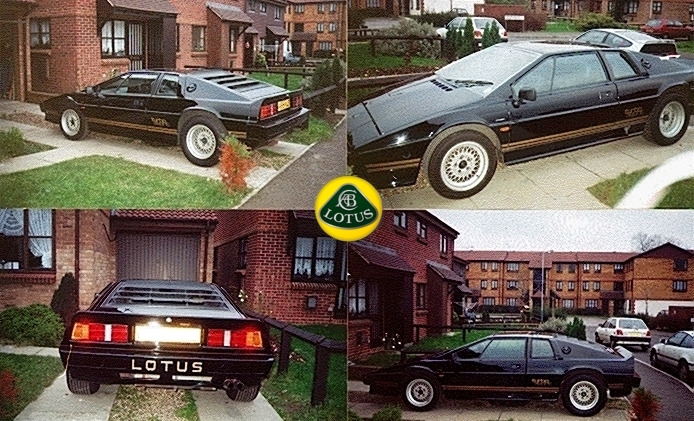
The Peter Stevens shape car, the X180, emerged
in 1987 and with it, the last Giugiaro Esprit , the
Turbo HC, had been produced
Actually, although I'm far from convinced that the restyling can
be totally attributed to Stevens (compare it to the
Lotus Etna in the 909 V8 tab in the
History section), I have never swayed in my admiration for
the original Giugiaro styling and I've never had any desires to
own the rounded 80s car, no matter how much power they gave it
The 80s was a LONG time ago now anyway and
the restyling is far from modern I've always held
the view that the Giugiaro original styling would become the
true classic and the 80s shape would loose it's relevence...
Things did arrive to tempt me though - or at least make me feel
bad that the Giugiaro, the Esprit design current when Lotus
had the fastest cars on the track, was no longer the fastest
Esprit - Fuel injection plus higher compression ratio on the Turbo
HC, had seen a modest 5 bhp rise from 210 to 215 bhp and more
efficient multi-point injection saw 228 bhp in the Steven's Esprit
in 1988 (enough in a "jelly-mold" shape to slightly peeve me!).
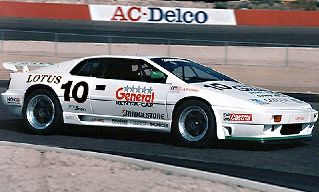
Then in 1989 things took on a much more serious with the long
vaunted arrival of an inter-cooled turbo engine, or more
accurately "charge-cooled" (using an air/water inter-cooler, with
a front mounted water coold radiator)... this
gave the newly named Turbo SE 264 bhp (with 280 bhp over boost
available for short periods) - This
started to leave the poor old Giugiaro performance behind, with
0-60 mph in 4.7 secs and 164 mph top speed... I wasn't happy!
Race versions, the Type 105/106 X180R (pictured left),
produced 285/300 bhp and were campaigned with considerable
success in the SCCA (Sports Car Club of America) by Doc
Bundy, who won the drivers title in 1992
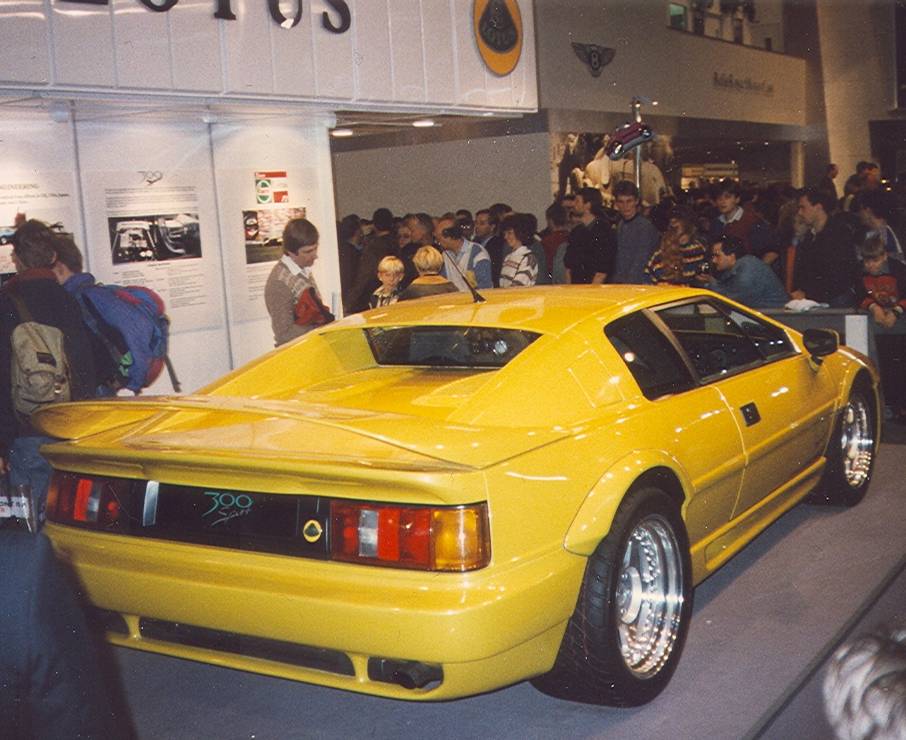
Worse still, 1993 saw the launch of the
Esprit Sport 300 road car - with a re-worked head,
hybrid turbo, larger charge-cooler and modified ECU, the power output from the venerable Lotus 4
cylinder engine was now 300 bhp! This gave 0-60 mph
in around 4.4 secs and 168 mph
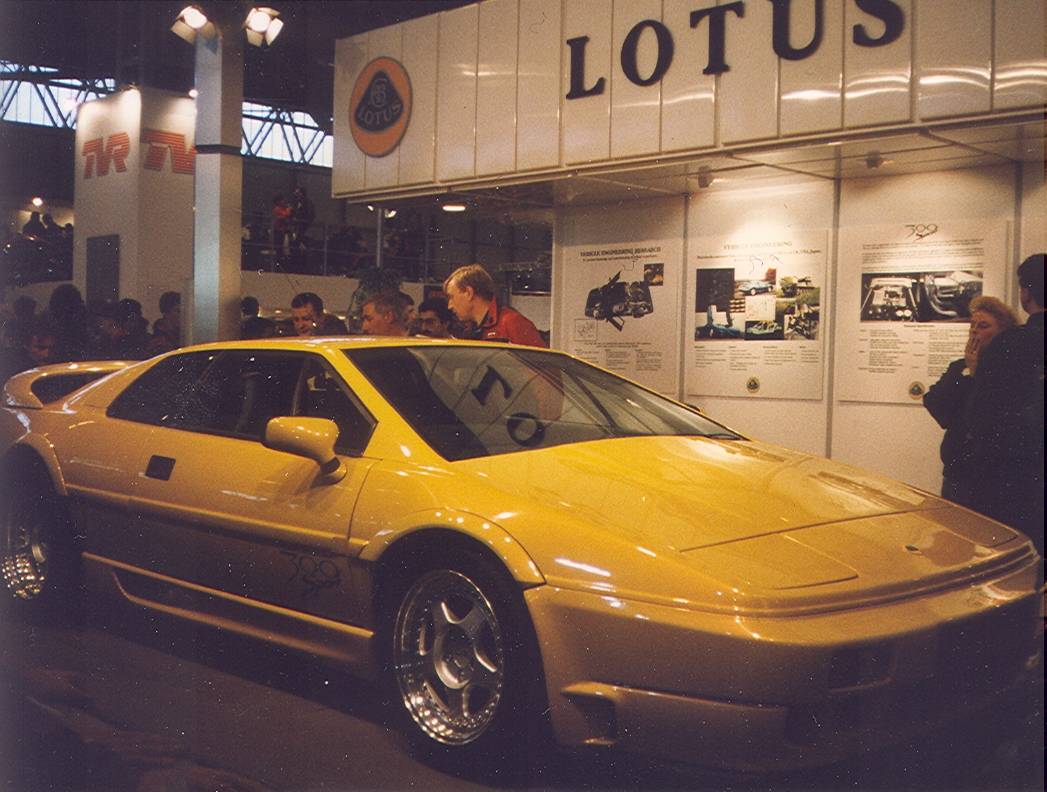
The Sport 300 was launched at Birmingham NEC - I was there,
feeling bemused and wondering if I could get the engine in my car!
(these are my own photos from the show)
Two works Sport 300's raced at Le Mans in 1993 for Lotus
Sport/Chamberlain Engineering Sport 300 (the first Lotus works
entry for over 30 years) and in 1994 Thorkild Thyrring won the
British National GT series driving a Sport 300
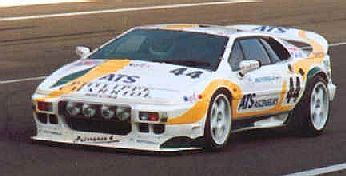
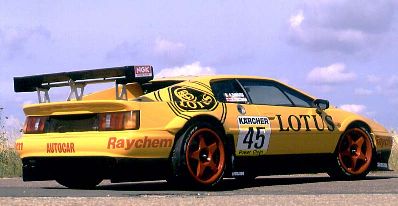
Some success had already been had with a 4 cylinder turbo car when
the Lotus GT car, driven by Allessandro Zanardi and Alex Portman,
lead the GT2 class ay Donington by over a lap, running up to third
overall
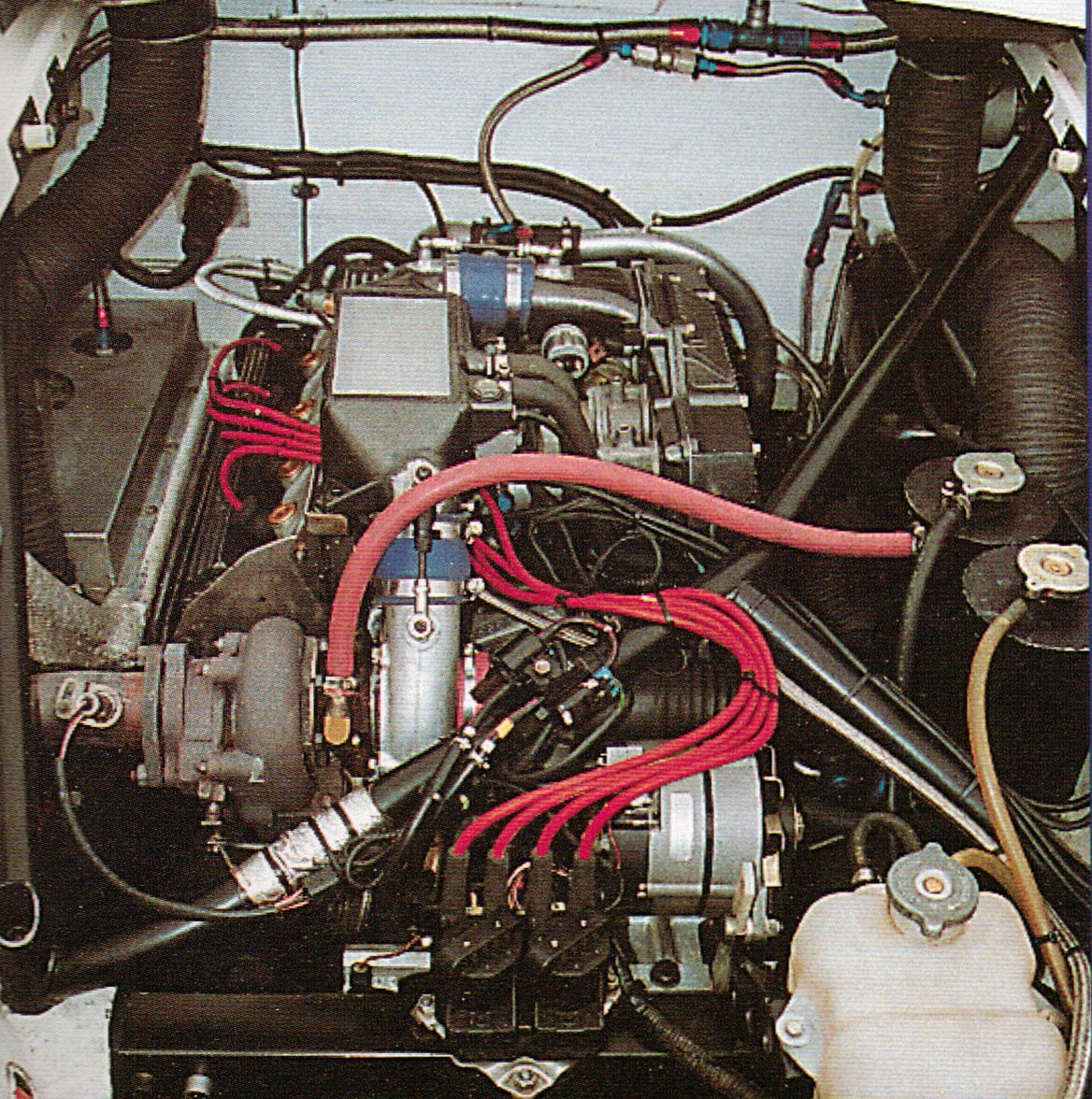
Only a transmission fault five minutes before the end of the
four-hour race prevented the team taking a fairy-tale result

In 1996 the all-new
Lotus Esprit GT1 car (type number 114) unveiled at Paul
Richard circuit for first race of 1996 GT series
After showing promise, the car retired with a
fractured exhaust nut Dutchman Jan Lammers enthused about car's
potential
Click the photo for more
details on the Esprit GT1
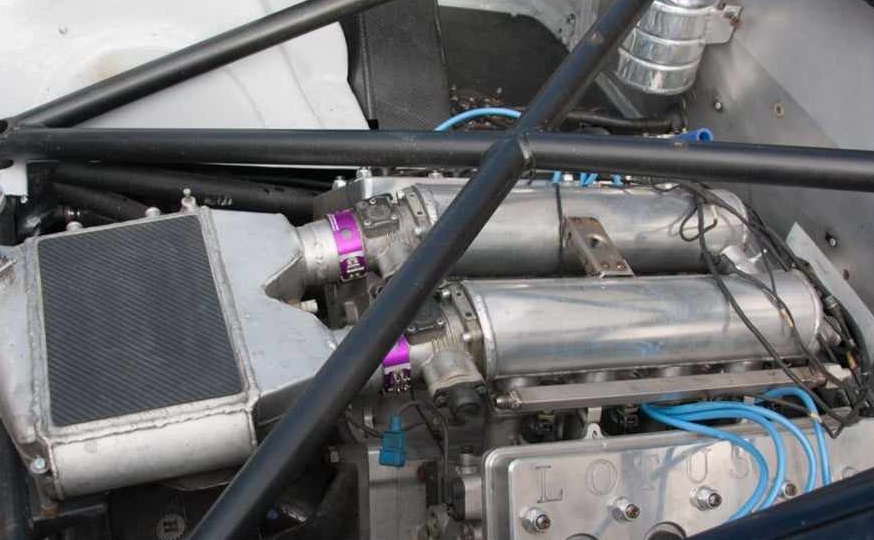
The car featured the then
still-secret Lotus V8 engine, a six-speed racing
transmission, F1-style aerodynamics, carbon brakes and was on
the 900 kg minimum weight limit

The Lotus 918 V8 Engine was also used in the Elise GT1 race car
for a short period, as seen on the right
Click the photo for more
details on the Elise GT1
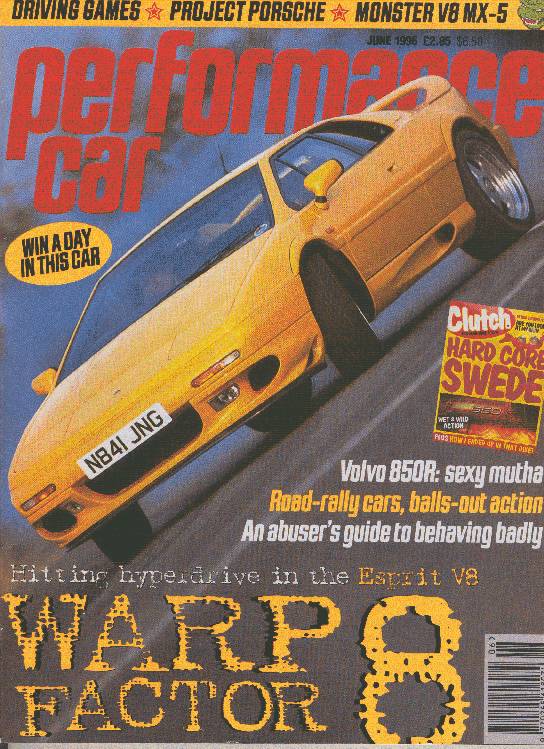
Time progressed though and as
those who know me will say, my Esprit became garage bound after
an exhaust manifold crack and subsequent engine removal
Lotus did me the huge favour of
announcing the use of their V8 twin turbo engine in the
production Esprit, as the cover of Performance
Car in 1996 on the left shows.
Esprit
V8 Official Press Release
Esprit V8 Promotion Video
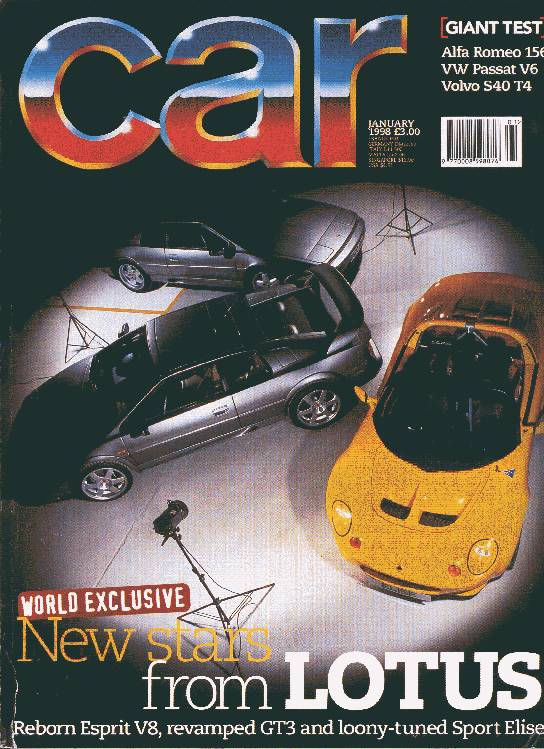
The history of this V8 engine is quite well known now and as the
cover of Car magazine in 1998 shows, a revised version appeared
that year with modifications to the clutch and timing belt
design
Esprit V8 Brands Hatch
So
now it would be possible to endow the Giugiaro Esprit with
an all Lotus design V8 engine and complete the original
oblective of the Project M71 program from the 1970s

Planning
got properly underway in 2001 when I formulated the idea of
locating a 918 V8 engine, an Esprit V8 chassis and suspension,
building a rolling chassis and then transplanting the Giugiaro
body from my car
Here's
my original scribblings of the plan - a real "back of a fag
packet" scheme! Still, it's always good to make a plan and it
looks easy on paper...

One thing was for sure, I would need a lot of manuals to
be able to do this project properly...
I already had the Turbo Esprit
and S3 Service Notes and 1980-87 Parts List from running the car
in standard form - but Parts Lists for all the 4 cylinder cars
from 1993 onwards and the V8 models were added
I also have Service Notes for
the V8 and, of course these days, all of these in pdf format
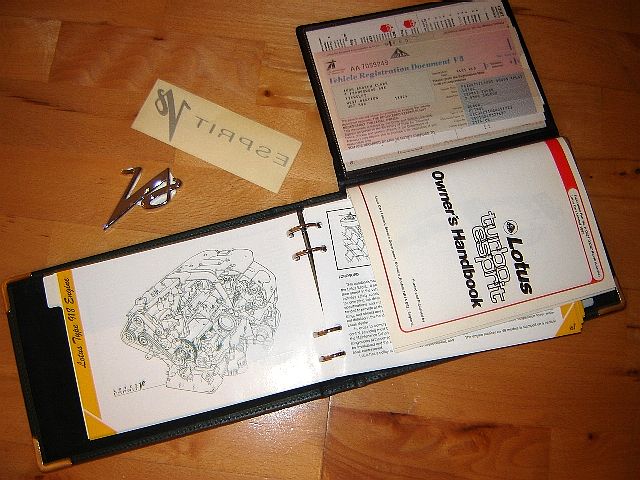
Planning well ahead, it was also fun to go
to a local Lotus dealer parts department and buy a V8 owners
manual...
After all I'll ready need two
- one for the Giugiaro body and controls etc and one for the V8
engine etc.
The V8 version is made with a
lovely leather cover and the old Turbo Esprit one fits in the
back!
Being ever the optimist, I
also got a V8 badge and decal for the engine compartment window!














